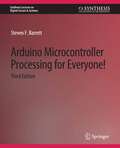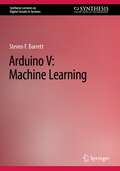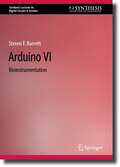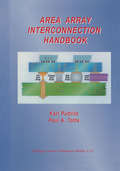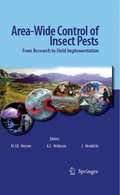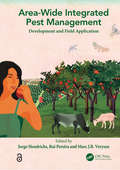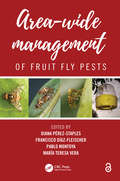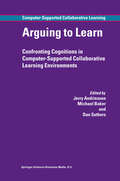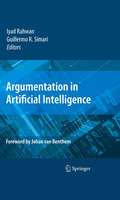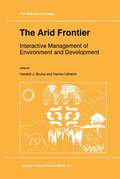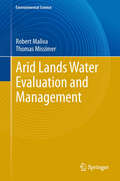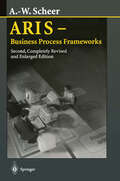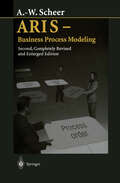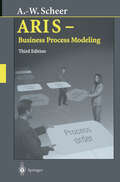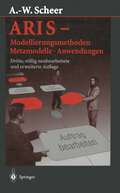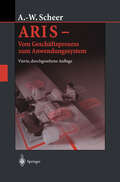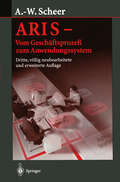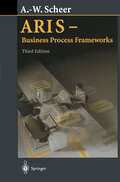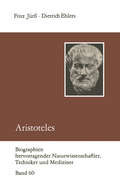- Table View
- List View
Arduino Microcontroller Processing for Everyone! Third Edition (Synthesis Lectures on Digital Circuits & Systems)
by Steven F. BarrettThis book is about the Arduino microcontroller and the Arduino concept. The visionary Arduino team of Massimo Banzi, David Cuartielles, Tom Igoe, Gianluca Martino, and David Mellis launched a new innovation in microcontroller hardware in 2005, the concept of open source hardware. Their approach was to openly share details of microcontroller-based hardware design platforms to stimulate the sharing of ideas and promote innovation. This concept has been popular in the software world for many years. This book is intended for a wide variety of audiences including students of the fine arts, middle and senior high school students, engineering design students, and practicing scientists and engineers. To meet this wide audience, the book has been divided into sections to satisfy the need of each reader. The book contains many software and hardware examples to assist the reader in developing a wide variety of systems. The book covers two different Arduino products: the Arduino UNO R3 equipped with the Atmel ATmega328 and the Arduino Mega 2560 equipped with the Atmel ATmega2560. The third edition has been updated with the latest on these two processing boards, changes to the Arduino Development Environment and multiple extended examples.
Arduino V: Machine Learning (Synthesis Lectures on Digital Circuits & Systems)
by Steven F. BarrettThis book is about the Arduino microcontroller and the Arduino concept. The visionary Arduino represented a new innovation in microcontroller hardware in 2005, the concept of open source hardware, making a broad range of computing accessible for all.This book, “Arduino V: AI and Machine Learning,” is an accessible primer on Artificial Intelligence and Machine Learning for those without a deep AI and ML background. The author concentrates on Artificial Intelligence (AI) and Machine Learning (ML) applications for microcontroller–based systems. The intent is to introduce the concepts and allow readers to practice on low cost, accessible Arduino hardware and software. Readers should find this book a starting point, an introduction, to this fascinating field. A number of references are provided for further exploration.
Arduino VI: Bioinstrumentation (Synthesis Lectures on Digital Circuits & Systems)
by Steven F. BarrettThis book is about the Arduino microcontroller and the Arduino concept. The visionary Arduino team represented a new innovation in microcontroller hardware in 2005, the concept of open source hardware, making a broad range of computing accessible for all. This book, “Arduino VI: Bioinstrumentation,” is an accessible primer on bioinstrumentation for those without a deep instrumentation background. An understanding of basic circuit theory is an appropriate prerequisite for the book. The three main goals for the book are: explore accessible Arduino microcontroller programming and interfacing concepts; investigate the source and measurement of biomedical signals; and develop skills to design and implement biomedical instrumentation.
Area Array Interconnection Handbook
by Karl J. Puttlitz Paul A. TottaMicroelectronic packaging has been recognized as an important "enabler" for the solid state revolution in electronics which we have witnessed in the last third of the twentieth century. Packaging has provided the necessary external wiring and interconnection capability for transistors and integrated circuits while they have gone through their own spectacular revolution from discrete device to gigascale integration. At IBM we are proud to have created the initial, simple concept of flip chip with solder bump connections at a time when a better way was needed to boost the reliability and improve the manufacturability of semiconductors. The basic design which was chosen for SLT (Solid Logic Technology) in the 1960s was easily extended to integrated circuits in the '70s and VLSI in the '80s and '90s. Three I/O bumps have grown to 3000 with even more anticipated for the future. The package families have evolved from thick-film (SLT) to thin-film (metallized ceramic) to co-fired multi-layer ceramic. A later family or ceramics with matching expansivity to sili con and copper internal wiring was developed as a predecessor of the chip interconnection revolution in copper, multilevel, submicron wiring. Powerful server packages have been de veloped in which the combined chip and package copper wiring exceeds a kilometer. All of this was achieved with the constant objective of minimizing circuit delays through short, efficient interconnects.
Area-Based Management of Shipping: Canadian and Comparative Perspectives
by Claudio Aporta Aldo Chircop Floris Goerlandt Ronald PelotThis open access book fills a gap in the literature on shipping in a number of cross-cutting fields (including marine transportation law and policy, law of the sea, Indigenous rights, marine environmental management, and risk and safety studies). Moreover, the book includes a focus on the consideration of Indigenous rights in shipping, a topic of emerging importance. There are, to our knowledge, no directly competing titles with the same interdisciplinary approach to conceptualize, understand, and describe best practices for area-based management approaches. There are, however, related titles which cover some aspects of area-based management, usually from narrow disciplinary perspectives. Area-based management in the governance of shipping has become a useful and effective approach to promote maritime safety, maritime security, and pollution prevention and to mitigate the adverse impacts of shipping on the marine environment and coastal communities. Based on the results of a research project and a major workshop convened at Dalhousie University in Canada, this book consists of multidisciplinary studies and analyses of major issues pertaining to area-based management in shipping from a comparative perspective, but with the principal focus on Canada. The book contains both theoretical and empirical contributions.
Area-Wide Control of Insect Pests: From Research to Field Implementation
by M. J. B. Vreysen A. S. Robinson J. HendrichsInsect pests are becoming a problem of ever-more biblical proportions. This new textbook collates a series of selected papers that attempt to address various fundamental components of area-wide insect pest control. Of special interest are the numerous papers on pilot and operational programs that pay special attention to practical problems encountered during program implementation. It’s a compilation of more than 60 papers authored by experts from more than 30 countries.
Area-wide Integrated Pest Management: Development and Field Application
by Jorge Hendrichs Rui Pereira Marc J. B. VreysenOver 98% of sprayed insecticides and 95% of herbicides reach a destination other than their target species, including non-target species, air, water and soil. The extensive reliance on insecticide use reduces biodiversity, contributes to pollinator decline, destroys habitat, and threatens endangered species. This book offers a more effective application of the Integrated Pest Management (IPM) approach, on an area-wide (AW) or population-wide (AW-IPM) basis, which aims at the management of the total population of a pest, involving a coordinated effort over often larger areas. For major livestock pests, vectors of human diseases and pests of high-value crops with low pest tolerance, there are compelling economic reasons for participating in AW-IPM. This new textbook attempts to address various fundamental components of AW-IPM, e.g. the importance of relevant problem-solving research, the need for planning and essential baseline data collection, the significance of integrating adequate tools for appropriate control strategies, and the value of pilot trials, etc. With chapters authored by 184 experts from more than 31 countries, the book includes many technical advances in the areas of genetics, molecular biology, microbiology, resistance management, and social sciences that facilitate the planning and implementing of area-wide strategies. The book is essential reading for the academic and applied research community as well as national and regional government plant and human/animal health authorities with responsibility for protecting plant and human/animal health.
Area-wide Integrated Pest Management: Development and Field Application
by Jorge Hendrichs; Rui Pereira; Marc J.B. VreysenOver 98% of sprayed insecticides and 95% of herbicides reach a destination other than their target species, including non-target species, air, water and soil. The extensive reliance on insecticide use reduces biodiversity, contributes to pollinator decline, destroys habitat, and threatens endangered species. This book offers a more effective application of the Integrated Pest Management (IPM) approach, on an area-wide (AW) or population-wide (AW-IPM) basis, which aims at the management of the total population of a pest, involving a coordinated effort over often larger areas. For major livestock pests, vectors of human diseases and pests of high-value crops with low pest tolerance, there are compelling economic reasons for participating in AW-IPM. This new textbook attempts to address various fundamental components of AW-IPM, e.g. the importance of relevant problem-solving research, the need for planning and essential baseline data collection, the significance of integrating adequate tools for appropriate control strategies, and the value of pilot trials, etc. With chapters authored by 184 experts from more than 31 countries, the book includes many technical advances in the areas of genetics, molecular biology, microbiology, resistance management, and social sciences that facilitate the planning and implementing of area-wide strategies. The book is essential reading for the academic and applied research community as well as national and regional government plant and human/animal health authorities with responsibility for protecting plant and human/animal health.
Area-Wide Management of Fruit Fly Pests
by Pablo Montoya Diana Perez-Staples Francisco Diaz-Fleischer Maria Teresa VeraFruit fly (Diptera: Tephritidae) pests have a profound impact on horticultural production and economy of many countries. It is fundamental to understand their biology and evaluate methods for their suppression, containment, or eradication. Area-Wide Management of Fruit Fly Pests comprises contributions from scientists from around the world on several species of tephritids working on diverse subjects with a focus on area-wide management of these pests. The first three sections of the book explore aspects of the biology, ecology, physiology, behavior, taxonomy, and morphology of fruit flies. The next two sections provide evidence on the efficacy of attractants, risk assessment, quarantine, and post-harvest control methods. The fifth and sixth sections examine biological control methods such as the Sterile Insect Technique and the use of natural enemies of fruit flies. The seventh section focuses on area-wide integrated pest management and action programs. Finally, the eighth section examines social, economic, and policy issues of action programs aimed at involving the wider community in the control of these pests and facilitate the development of control programs. Features: Presents information on the biology of tephritid flies. Provides knowledge on the use of natural enemies of fruit flies for their biological control. Includes research results on models and diets used for the Sterile Insect Technique. Reports developments on the chemical ecology of fruit flies that contribute to make control methods more specific and efficient. Reviews subjects such as Holistic Pest Management and Area-Wide Management Programs including social, economic, and policy issues in various countries. The Open Access version of this book, available at https://www.taylorfrancis.com/books/9780429355738, has been made available under a Creative Commons Attribution-Non Commercial-No Derivatives 4.0 license.
Area-Wide Management of Fruit Fly Pests
by Pablo Montoya Diana Perez-Staples Francisco Diaz-Fleischer Maria Teresa VeraFruit fly (Diptera: Tephritidae) pests have a profound impact on horticultural production and economy of many countries. It is fundamental to understand their biology and evaluate methods for their suppression, containment, or eradication. Area-Wide Management of Fruit Fly Pests comprises contributions from scientists from around the world on several species of tephritids working on diverse subjects with a focus on area-wide management of these pests. The first three sections of the book explore aspects of the biology, ecology, physiology, behavior, taxonomy, and morphology of fruit flies. The next two sections provide evidence on the efficacy of attractants, risk assessment, quarantine, and post-harvest control methods. The fifth and sixth sections examine biological control methods such as the Sterile Insect Technique and the use of natural enemies of fruit flies. The seventh section focuses on area-wide integrated pest management and action programs. Finally, the eighth section examines social, economic, and policy issues of action programs aimed at involving the wider community in the control of these pests and facilitate the development of control programs. Features: Presents information on the biology of tephritid flies. Provides knowledge on the use of natural enemies of fruit flies for their biological control. Includes research results on models and diets used for the Sterile Insect Technique. Reports developments on the chemical ecology of fruit flies that contribute to make control methods more specific and efficient. Reviews subjects such as Holistic Pest Management and Area-Wide Management Programs including social, economic, and policy issues in various countries. The Open Access version of this book, available at https://www.taylorfrancis.com/books/9780429355738, has been made available under a Creative Commons Attribution-Non Commercial-No Derivatives 4.0 license.
Argillaceous Rock Atlas
by Neal R. O'Brien Roger M. SlattA major reason for the lack of understanding of argillaceous rocks is that the key to understanding their history lies in their microfabric. Argillaceous Rock Atlas addresses this aspect by taking a systematic approach to the analysis of shale fabrics. This approach combines such techniques as scanning electron microscopy, x-radiography and thin-section petrography. Thus the book is amply illustrated with scanning electron and thin section photomicrographs and x-radiograms which show the salient features of shale at a variety of scales. A great portion of the book is devoted to case studies, supplemented by mineralogical and geochemical data, which demonstrate the utility of these techniques in the interpretation of depositional environments, diagenetic processes and possible economic significance of argillaceous rocks. Argillaceous Rock Atlas is a valuable and unique reference for students and researchers involved in the fields of sedimentology and stratigraphy, petrology, petroleum geology, hydrogeology and geochemistry.
Arguing to Learn: Confronting Cognitions in Computer-Supported Collaborative Learning Environments (Computer-Supported Collaborative Learning Series #1)
by Jerry AndriessenThis book focuses on how new pedagogical scenarios, task environments and communication tools within Computer-Supported Collaborative Learning (CSCL) environments can favour collaborative and productive confrontations of ideas, evidence, arguments and explanations, or arguing to learn. The first to assemble the work of internationally renowned scholars, this book will be of interest to researchers in education, psychology, computer science, communication and linguistic studies
Argumentation in Artificial Intelligence
by Iyad RahwanArgumentation is all around us. Letters to the Editor often make points of cons- tency, and “Why” is one of the most frequent questions in language, asking for r- sons behind behaviour. And argumentation is more than ‘reasoning’ in the recesses of single minds, since it crucially involves interaction. It cements the coordinated social behaviour that has allowed us, in small bands of not particularly physically impressive primates, to dominate the planet, from the mammoth hunt all the way up to organized science. This volume puts argumentation on the map in the eld of Arti cial Intelligence. This theme has been coming for a while, and some famous pioneers are chapter authors, but we can now see a broader systematic area emerging in the sum of topics and results. As a logician, I nd this intriguing, since I see AI as ‘logic continued by other means’, reminding us of broader views of what my discipline is about. Logic arose originally out of re ection on many-agent practices of disputation, in Greek Ant- uity, but also in India and China. And logicians like me would like to return to this broader agenda of rational agency and intelligent interaction. Of course, Aristotle also gave us a formal systems methodology that deeply in uenced the eld, and eventually connected up happily with mathematical proof and foundations.
The Arid Frontier: Interactive Management of Environment and Development (GeoJournal Library #41)
by Hendrik J. Bruins Harvey LithwickThe arid frontier has been a challenge for humanity from time immemorial. Drylands cover more than one-third of the global land surface, distributed over Africa, Asia, Australia, America and Southern Europe. Disasters may develop as a result of complex interactions between drought, desertification and society. Therefore, proactive planning and interactive management, including disaster-coping strategies, are essential in dealing with arid-frontier development. This book presents a conceptual framework with case studies in dryland development and management. The option of a rational and ethical discourse for development that is beneficial for both the environment and society is emphasized, avoiding extreme environmentalism and human destructionism, combating both desertification and human livelihood insecurity. Such development has to be based on appropriate ethics, legislation, policy, proactive planning and interactive management. Excellent scholars address these issues, focusing on the principal interactions between people and dryland environments in terms of drought, food, land, water, renewable energy and housing. Audience: This volume will be of great value to all those interested in Dryland Development and Management: professionals and policy-makers in governmental, international and non-governmental organizations (NGOs), as well as researchers, lecturers and students in Geography, Environmental Management, Regional Studies, Development Anthropology, Hazard and Disaster Management, Agriculture and Pastoralism, Land and Water Use, African Studies, and Renewable Energy Resources.
Arid Lands Water Evaluation and Management (Environmental Science and Engineering)
by Robert Maliva Thomas MissimerA large part of the global population lives in arid lands which have low rainfall and often lack the water required for sustainable population and economic growth. This book presents a comprehensive description of the hydrogeology and hydrologic processes at work in arid lands. It describes the techniques that can be used to assess and manage the water resources of these areas with an emphasis on groundwater resources, including recent advances in hydrologic evaluation and the differences between how aquifer systems behave in arid lands versus more humid areas. Water management techniques are described and summarized to show how a more comprehensive approach to water management is required in these areas, including the need to be aware of cultural sensitivities and conditions unique to many arid regions. The integration of existing resources with the addition of new water sources, such as desalination of brackish water and seawater, along with reusing treated wastewater, will be required to meet future water supply needs. Also, changing climatic conditions will force water management systems to be more robust so that future water supply demands can be met as droughts become more intense and rainfall events become more intense. A range of water management techniques are described and discussed in order to illustrate the methods for integrating these measures within the context of arid lands conditions.
ARIS — Business Process Frameworks
by August-Wilhelm ScheerARIS (Architecture of Integrated Information Systems) is a unique and internationally renowned method for optimizing business processes and implementing application systems. This book enhances the proven ARIS concept by describing product flows and explaining how to classify modern software concepts. The importance of the link between business process organization and strategic management is stressed. Bridging the gap between the different approaches in business theory and information technology, the ARIS concept provides a full-circle approach-from the organizational design of business processes to IT implementation. With an emphasis on SAP R/3, real-world examples of standard software solutions illustrate these business process frameworks.
ARIS — Business Process Modeling
by August-Wilhelm ScheerThis book describes in detail how ARIS methods model and identify business processes by means of the UML (Unified Modeling Language), leading to an information model that serves as the basis for a systematic and intelligent development of application systems. Multiple real-world examples using SAP R/3 illustrate aspects of business process modeling including methods of knowledge management, implementation of workflow systems and standard software solutions, and the deployment of ARIS methods.
ARIS — Business Process Modeling
by August-Wilhelm ScheerThis book describes in detail how ARIS methods model and identify business processes by means of the UML (Unified Modeling Language), leading to an information model that serves as the basis for a systematic and intelligent development of application systems. Multiple real-world examples using SAP R/3 illustrate aspects of business process modeling including methods of knowledge management, implementation of workflow systems and standard software solutions, and the deployment of ARIS methods.
ARIS — Vom Geschäftsprozess zum Anwendungssystem
by August-Wilhelm ScheerDie "Architektur integrierter Informationssystme" ARIS hat sich zur Optimierung von Geschäftsprozessen und zur Einführung von Anwendungssystemen auch international durchgesetzt. In diesem Buch wird der Ansatz um die Beschreibung von Leistungsflüssen und die Einordnung moderner Softwarekonzepte erweitert. Auch die Anbindung der Geschäftsprozessorganisation an die strategische Unternehmensplanung wird stärker betont. Das ARIS-Konzept zeigt einen geschlossenen Weg von der organisatorischen Gestaltung von Geschäftsprozessen bis zur informationstechnischen Umsetzung. Es vermittelt somit zwischen den Verständniswelten der Betriebswirtschaftslehre und der Informationstechnik. Praktische Beispiele von Standardsoftware, insbesondere SAP R/3, veranschaulichen die Ausführungen.
ARIS - Business Process Frameworks
by August-Wilhelm ScheerARIS (Architecture of Integrated Information Systems) is a unique and internationally renowned method for optimizing business processes and implementing application systems. This book enhances the proven ARIS concept by describing product flows and explaining how to classify modern software concepts. The importance of the link between business process organization and strategic management is stressed. Bridging the gap between the different approaches in business theory and information technology, the ARIS concept provides a full-circle approach-from the organizational design of business processes to IT implementation. With an emphasis on SAP R/3, real-world examples of standard software solutions illustrate these business process frameworks.
Aristoteles (Biographien hervorragender Naturwissenschaftler, Techniker und Mediziner #60)
by Fritz Jürss Dietrich EhlersArithmetic and Algebraic Circuits (Intelligent Systems Reference Library #201)
by Antonio Lloris Ruiz Encarnación Castillo Morales Luis Parrilla Roure Antonio García Ríos María José Lloris MeseguerThis book presents a complete and accurate study of arithmetic and algebraic circuits. The first part offers a review of all important basic concepts: it describes simple circuits for the implementation of some basic arithmetic operations; it introduces theoretical basis for residue number systems; and describes some fundamental circuits for implementing the main modular operations that will be used in the text. Moreover, the book discusses floating-point representation of real numbers and the IEEE 754 standard. The second and core part of the book offers a deep study of arithmetic circuits and specific algorithms for their implementation. It covers the CORDIC algorithm, and optimized arithmetic circuits recently developed by the authors for adders and subtractors, as well as multipliers, dividers and special functions. It describes the implementation of basic algebraic circuits, such as LFSRs and cellular automata. Finally, it offers a complete study of Galois fields, showing some exemplary applications and discussing the advantages in comparison to other methods. This dense, self-contained text provides students, researchers and engineers, with extensive knowledge on and a deep understanding of arithmetic and algebraic circuits and their implementation.
Arithmetic Circuits for DSP Applications
by Pramod Kumar Meher Thanos StouraitisA comprehensive guide to the fundamental concepts, designs, and implementation schemes, performance considerations, and applications of arithmetic circuits for DSP Arithmetic Circuits for DSP Applications is a complete resource on arithmetic circuits for digital signal processing (DSP). It covers the key concepts, designs and developments of different types of arithmetic circuits, which can be used for improving the efficiency of implementation of a multitude of DSP applications. Each chapter includes various applications of the respective class of arithmetic circuits along with information on the future scope of research. Written for students, engineers, and researchers in electrical and computer engineering, this comprehensive text offers a clear understanding of different types of arithmetic circuits used for digital signal processing applications. The text includes contributions from noted researchers on a wide range of topics, including a review of circuits used in implementing basic operations like additions and multiplications; distributed arithmetic as a technique for the multiplier-less implementation of inner products for DSP applications; discussions on look up table-based techniques and their key applications; CORDIC circuits for calculation of trigonometric, hyperbolic and logarithmic functions; real and complex multiplications, division, and square-root; solution of linear systems; eigenvalue estimation; singular value decomposition; QR factorization and many other functions through the use of simple shift-add operations; and much more. This book serves as a comprehensive resource, which describes the arithmetic circuits as fundamental building blocks for state-of-the-art DSP and reviews in - depth the scope of their applications.
